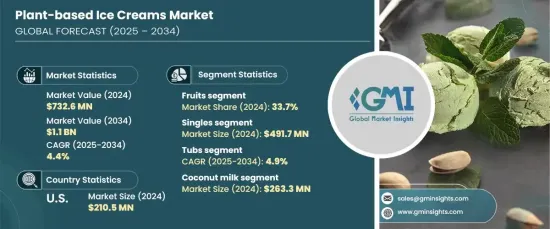
|
시장보고서
상품코드
1666611
식물성 아이스크림 시장 기회, 성장 촉진요인, 산업 동향 분석 및 예측(2025-2034년)Plant-based Ice Creams Market Opportunity, Growth Drivers, Industry Trend Analysis, and Forecast 2025 - 2034 |
||||||
세계의 식물성 아이스크림 시장은 2024년에는 7억 3,260만 달러로 평가되었고 2025년부터 2034년까지 연평균 복합 성장률(CAGR) 4.4%로 성장할 것으로 예측됩니다. 지속가능하고 건강을 지향하는 식품에 대한 수요 증가는 이 시장의 확대에 큰 역할을 하고 있습니다. 소비자는 전통적인 유제품 아이스크림에서 식물성 대체품을 선호합니다. 이 아이스크림은 종종 포화 지방이 낮고 유당이 없으며 콜레스테롤이 없는 경우가 많으며 건강한 간식을 원하는 사람들에게 매력적인 선택입니다. 게다가, 낙농이 환경에 미치는 영향에 대한 우려 증가도 이산화탄소 배출량을 줄이는 방법을 요구하는 개인 증가에 따라 시장 성장에 기여하고 있습니다.

혁신적인 식품 기술은 식물성 아이스크림 제조의 진보에 매우 중요한 역할을 해왔습니다. 이러한 기술 혁신에 의해 제조업체는 종래의 유제품 아이스크림의 풍미, 식감, 크림을 충실하게 모방한 제품을 만들어 내고, 호화스러운 냉동 디저트에 대한 소비자의 기대에 부응하고 있습니다. 이러한 기술적 진보로 식물성 아이스크림의 품질이 향상되었을 뿐만 아니라 보다 입수하기 쉬워지고 이러한 대체품의 매력이 넓어지고 있습니다. 소비자의 건강 지향과 환경 의식이 높아짐에 따라 식물성 아이스크림 수요는 계속 증가하고 있습니다. 시장의 성장은 다양한 식생활의 취향과 라이프 스타일에 부응하는 제품의 다양성에 의해 더욱 가속화되고 있습니다. 시장의 성장은 다양한 음식의 선호와 라이프 스타일에 대응하는 제품의 다양화로 더욱 가속화되고 있습니다.
| 시장 범위 | |
|---|---|
| 시작 연도 | 2024년 |
| 예측 연도 | 2025-2034년 |
| 시작 금액 | 7억 3,260만 달러 |
| 예측 금액 | 11억 달러 |
| CAGR | 4.4% |
시장은 블렌드와 싱글 등 다양한 형태로 구분됩니다. 2024년 시장 규모는 4억 9,170만 달러로 평가되었으며 싱글 카테고리가 가장 큰 점유율을 차지했습니다. 싱글을 선호하는 것은 생산이 더 쉽고 가격이 저렴하며 소비자에게 더 편리하기 때문입니다. 이러한 제품은 저장이 용이하고 추가 준비 없이 소비할 수 있으므로 바쁜 소비자에게 이상적인 선택입니다. 또한 싱글의 간단한 특성 덕분에 라벨링의 투명성이 높아져 식품 선택에 있어 단순함과 명확성을 우선시하는 고객들을 끌어들일 수 있습니다.
맛의 면에서는 과일 풍미의 식물성 아이스크림이 최대의 점유율을 차지해, 2024년 시장의 약 33.7%를 차지했습니다. 과일 베이스의 선택은 신선함과 건강상의 이점을 연상시키는 경우가 많기 때문에 보다 건강하고 자연스러운 대체 디저트를 요구하는 소비자들 사이에서 인기가 있습니다. 과일 풍미에 대한 선호도 증가는 식물성 및 유제품 미사용 디저트에 대한 수요 증가와 일치합니다.
포장의 기호도 지속가능성으로 이동하고 있으며, 튜브 포장이 시장을 석권하고 있습니다. 소비자는 환경 친화적인 포장을 요구하는 경향이 강해지고 있으며, 판지나 생분해성 플라스틱 등, 생분해성이나 재활용 가능한 소재에 대한 수요가 높아지고 있습니다. 튜브 포장의 편의성과 지속가능성이 이 동향을 뒷받침하는 큰 요인이 되고 있습니다.
코코넛 우유 기반의 식물성 아이스크림이 시장을 선도하고 2024년 시장 규모는 2억 6,330만 달러에 달했습니다. 코코넛 밀크는 크림 같은 식감과 건강한 지방분이 선호되어 아이스크림 제조의 뛰어난 베이스가 되고 있습니다. 또한 생산자에게 비용 효율적인 옵션이기도 합니다. 슈퍼마켓/하이퍼마켓은 식물성 아이스크림의 유통 채널로 시장의 대부분을 차지합니다. 이 소매점은 다양한 유형의 제품을 제공하고 종종 캠페인을 실시하기 때문에 식물성 아이스크림이 더 저렴한 가격으로 광범위한 소비자층에 쉽게 접근할 수 있습니다.
미국의 식물성 아이스크림 시장은 기존의 유제품을 대체하는 보다 건강하고 지속 가능한 대체품에 대한 소비자 수요가 증가함에 따라 큰 성장을 이루고 있습니다. 유당 불내증에 대한 의식의 고조, 채식주의자의 식생활, 낙농에 의한 환경에 대한 영향에 대한 우려 등의 동향이 이 경향에 박차를 가하고 있습니다. 미국 시장은 풍미와 배합의 혁신, 전자상거래와 소매점을 통해 이들 제품을 쉽게 입수할 수 있다는 점도 뒷받침하고 있습니다.
목차
제1장 조사 방법과 조사 범위
- 시장 범위와 정의
- 기본 추정과 계산
- 예측 계산
- 데이터 소스
- 1차 데이터
- 2차 데이터
- 유료 소스
- 공개 소스
제2장 주요 요약
제3장 업계 인사이트
- 생태계 분석
- 밸류체인에 영향을 주는 요인
- 이익률 분석
- 방해
- 향후 전망
- 제조업체
- 유통업체
- 공급자의 상황
- 이익률 분석
- 주요 뉴스
- 규제 상황
- 영향요인
- 성장 촉진요인
- 유제품 미사용 및 채식주의 대체 식품에 대한 소비자 수요 증가
- 식품기술의 진보
- 환경의 지속가능성과 윤리적 배려
- 업계의 잠재적 위험 및 과제
- 기존 아이스크림과의 경쟁
- 인지도의 부족
- 성장 촉진요인
- 성장 가능성 분석
- Porter's Five Forces 분석
- PESTEL 분석
제4장 경쟁 구도
- 서론
- 기업 점유율 분석
- 경쟁 포지셔닝 매트릭스
- 전략 전망 매트릭스
제5장 시장 추계·예측 : 형태별(2021-2034년), 100만 달러, 킬로톤
- 주요 동향
- 블렌드
- 싱글
제6장 시장 추계·예측 : 풍미별(2021-2034년), 100만 달러, 킬로톤
- 주요 동향
- 콩
- 견과류
- 과일
- 허브
- 기타(캐러멜, 바닐라)
제7장 시장 추계·예측 : 포장 유형별(2021-2034년), 100만 달러, 킬로톤
- 주요 동향
- 튜브
- 콘
- 바
- 기타(sundae 컵, 뚜껑이 있는 컵)
제8장 시장추계·예측 : 원료별(2021-2034년), 100만 달러, 킬로톤
- 주요 동향
- 코코넛 밀크
- 두유
- 아몬드 밀크
- 캐슈 밀크
- 기타(귀리 밀크, 쌀 밀크)
제9장 시장 추계·예측 : 유통 채널별(2021-2034년), 100만 달러, 킬로톤
- 주요 동향
- 슈퍼마켓/하이퍼마켓
- 편의점
- 전문점
- 온라인 소매
제10장 시장 추계·예측 : 지역별(2021-2034년), 100만 달러, 킬로톤
- 주요 동향
- 북미
- 미국
- 캐나다
- 유럽
- 영국
- 독일
- 프랑스
- 이탈리아
- 스페인
- 러시아
- 아시아태평양
- 중국
- 인도
- 일본
- 한국
- 호주
- 라틴아메리카
- 브라질
- 멕시코
- 중동 및 아프리카
- 남아프리카
- 사우디아라비아
- 아랍에미리트(UAE)
제11장 기업 프로파일
- Alpro
- Ben &Jerrys Homemade
- Bliss Unlimited
- Frankie &Jos
- Haagen Dazs
- Happy Cow
- Jollyum
- Kleins Ice Cream
- Little babys Ice cream
- Luna &Larrys Coconut Bliss
- LUV Ice Cream
- Oatly
- SO DELICIOUS DAIRY FREE
The Global Plant-Based Ice Creams Market is projected to reach USD 732.6 million in 2024 and grow at a CAGR of 4.4% from 2025 to 2034. Rising demand for sustainable and health-conscious food choices has played a significant role in this market's expansion. Consumers are increasingly moving away from traditional dairy ice creams in favor of plant-based alternatives. These ice creams often have lower levels of saturated fat, are lactose-free, and do not contain cholesterol, making them an appealing choice for those seeking a healthier treat. In addition, growing concerns about the environmental impact of dairy farming have also contributed to the market's growth as more individuals seek ways to reduce their carbon footprint.

Innovative food technology has played a pivotal role in advancing plant-based ice cream production. These innovations have helped manufacturers create products that closely mimic the flavor, texture, and creaminess of traditional dairy ice creams, meeting consumer expectations for an indulgent frozen dessert. These technical advancements have not only enhanced the quality of plant-based ice creams but also made them more accessible, broadening the appeal of these alternatives. As consumers become more health-conscious and environmentally aware, the demand for plant-based ice creams continues to rise. The market's growth is further fueled by a greater variety of products catering to different dietary preferences and lifestyles.
| Market Scope | |
|---|---|
| Start Year | 2024 |
| Forecast Year | 2025-2034 |
| Start Value | $732.6 Million |
| Forecast Value | $1.1 Billion |
| CAGR | 4.4% |
The market is segmented into various forms, including blends and singles. The singles category holds the largest share of the market, valued at USD 491.7 million in 2024. Singles are favored because they are simpler to produce, less expensive, and more convenient for consumers. These products are easy to store and consume without additional preparation, which makes them an ideal choice for busy consumers. The straightforward nature of singles also allows for greater transparency in labeling, attracting customers who prioritize simplicity and clarity in their food choices.
In terms of flavor, fruit-flavored plant-based ice creams account for the largest share, at around 33.7% of the market in 2024. Fruit-based options are popular among consumers looking for healthier and more natural dessert alternatives, as they are often associated with freshness and health benefits. This growing preference for fruit flavors aligns with the increasing demand for plant-based, dairy-free desserts.
Packaging preferences have also shifted toward sustainability, with tub packaging dominating the market. Consumers are increasingly seeking eco-friendly packaging, which has led to a rise in demand for biodegradable or recyclable materials, such as paperboard or biodegradable plastics. The convenience and sustainability of tub packaging are significant factors driving this trend.
Coconut milk-based plant-based ice creams lead the market, valued at USD 263.3 million in 2024. Coconut milk is favored for its creamy texture and healthy fat content, which makes it an excellent base for ice cream production. It is also a cost-effective choice for producers. Supermarkets and hypermarkets are the dominant distribution channels for plant-based ice creams, accounting for a major portion of the market. These retail outlets offer a wide range of products and often run promotions, making plant-based ice creams more affordable and accessible to a broad consumer base.
The U.S. plant-based ice cream market is experiencing significant growth, driven by increased consumer demand for healthier, more sustainable alternatives to traditional dairy products. Factors such as rising awareness of lactose intolerance, vegan diets, and concerns about the environmental impact of dairy farming have contributed to this trend. The market in the U.S. is also being driven by innovations in flavor and formulation, as well as the growing availability of these products through both e-commerce and retail stores.
Table of Contents
Chapter 1 Methodology & Scope
- 1.1 Market scope & definitions
- 1.2 Base estimates & calculations
- 1.3 Forecast calculations
- 1.4 Data sources
- 1.4.1 Primary
- 1.4.2 Secondary
- 1.4.2.1 Paid sources
- 1.4.2.2 Public sources
Chapter 2 Executive Summary
- 2.1 Industry synopsis, 2021-2034
Chapter 3 Industry Insights
- 3.1 Industry ecosystem analysis
- 3.1.1 Factor affecting the value chain
- 3.1.2 Profit margin analysis
- 3.1.3 Disruptions
- 3.1.4 Future outlook
- 3.1.5 Manufacturers
- 3.1.6 Distributors
- 3.2 Supplier landscape
- 3.3 Profit margin analysis
- 3.4 Key news & initiatives
- 3.5 Regulatory landscape
- 3.6 Impact forces
- 3.6.1 Growth drivers
- 3.6.1.1 Increasing consumer demand for dairy-free and vegan alternatives.
- 3.6.1.2 Advancements in food technology
- 3.6.1.3 Environmental sustainability and ethical considerations
- 3.6.2 Industry pitfalls & challenges
- 3.6.2.1 Competition from traditional ice cream
- 3.6.2.2 Lack of awareness
- 3.6.1 Growth drivers
- 3.7 Growth potential analysis
- 3.8 Porter’s analysis
- 3.9 PESTEL analysis
Chapter 4 Competitive Landscape, 2024
- 4.1 Introduction
- 4.2 Company market share analysis
- 4.3 Competitive positioning matrix
- 4.4 Strategic outlook matrix
Chapter 5 Market Estimates & Forecast, By Form, 2021-2034 (USD Million) (Kilo Tons)
- 5.1 Key trends
- 5.2 Blends
- 5.3 Singles
Chapter 6 Market Estimates & Forecast, By Flavor, 2021-2034 (USD Million) (Kilo Tons)
- 6.1 Key trends
- 6.2 Beans
- 6.3 Nuts
- 6.4 Fruits
- 6.5 Herbs
- 6.6 Others (caramel, vanilla)
Chapter 7 Market Estimates & Forecast, By Packaging Type, 2021-2034 (USD Million) (Kilo Tons)
- 7.1 Key trends
- 7.2 Tubs
- 7.3 Cones
- 7.4 Bars
- 7.5 Others (sundae cups, cups with lids)
Chapter 8 Market Estimates & Forecast, By Sources, 2021-2034 (USD Million) (Kilo Tons)
- 8.1 Key trends
- 8.2 Coconut milk
- 8.3 Soy milk
- 8.4 Almond milk
- 8.5 Cashew milk
- 8.6 Others (oat milk, rice milk)
Chapter 9 Market Estimates & Forecast, By Distribution Channel, 2021-2034 (USD Million) (Kilo Tons)
- 9.1 Key trends
- 9.2 Supermarkets and hypermarkets
- 9.3 Convenience stores
- 9.4 Specialty stores
- 9.5 Online retail
Chapter 10 Market Estimates & Forecast, By Region, 2021-2034 (USD Million) (Kilo Tons)
- 10.1 Key trends
- 10.2 North America
- 10.2.1 U.S.
- 10.2.2 Canada
- 10.3 Europe
- 10.3.1 UK
- 10.3.2 Germany
- 10.3.3 France
- 10.3.4 Italy
- 10.3.5 Spain
- 10.3.6 Russia
- 10.4 Asia Pacific
- 10.4.1 China
- 10.4.2 India
- 10.4.3 Japan
- 10.4.4 South Korea
- 10.4.5 Australia
- 10.5 Latin America
- 10.5.1 Brazil
- 10.5.2 Mexico
- 10.6 MEA
- 10.6.1 South Africa
- 10.6.2 Saudi Arabia
- 10.6.3 UAE
Chapter 11 Company Profiles
- 11.1 Alpro
- 11.2 Ben & Jerrys Homemade
- 11.3 Bliss Unlimited
- 11.4 Frankie & Jos
- 11.5 Haagen Dazs
- 11.6 Happy Cow
- 11.7 Jollyum
- 11.8 Kleins Ice Cream
- 11.9 Little babys Ice cream
- 11.10 Luna & Larrys Coconut Bliss
- 11.11 LUV Ice Cream
- 11.12 Oatly
- 11.13 SO DELICIOUS DAIRY FREE



















